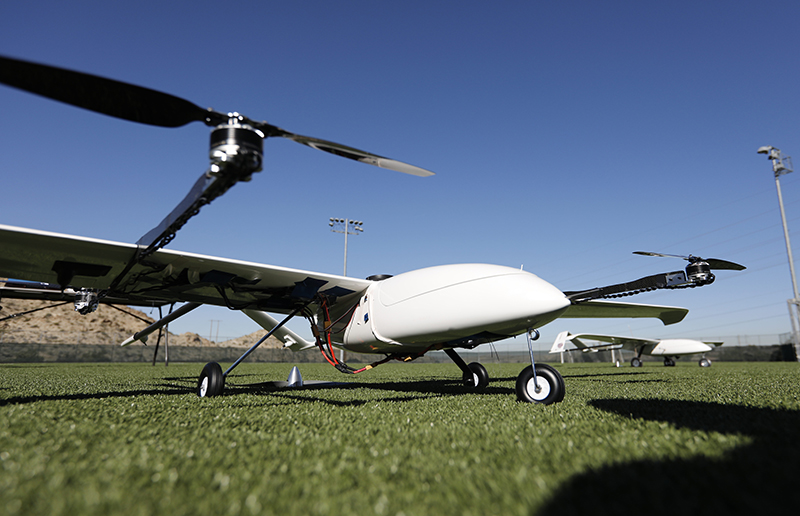UTEP to Host Inaugural U.S. Army Drone Design Competition
Last Updated on April 15, 2019 at 12:00 AM
Originally published April 15, 2019
By UC Staff
UTEP Communications
The University of Texas at El Paso will host the U.S. Army Combat Capabilities Development Command’s (CCDC) inaugural student unmanned aerial vehicle (UAV) design competition Tuesday, April 23 and Wednesday, April 24, 2019, at Sun Bowl Stadium.

In a competition challenge offered to more than 1,700 U.S. universities, the top 11 university teams, which includes a UTEP team, were selected to travel to El Paso for the finals. Each team will present its concepts and fly prototypes that address UAV technology gaps based on real-world challenges faced by Army researchers. In addition to challenging undergraduate students to propose solutions to real technological challenges faced by the U.S. Army, the competition also allows CCDC to introduce students to the scope and impact of Army science and technology careers, and fosters diversity of thought among the country’s current and future innovators.
Related: UTEP Student Team Ready to Compete at Drone Design Competition
The first day of the competition on Tuesday, April 23, will be devoted to staging and team practice sessions at Sun Bowl Stadium. A poster showcase and welcome reception will close the day at 5:30 p.m. at the Larry K. Durham Sports Center Hall of Champions. (See an event map of Sun Bowl Stadium.)
On Wednesday, April 24, Sun Bowl Stadium will open from 9 a.m. to noon, and the competition itself is scheduled from 10 a.m. to noon on the field. A technology expo will take place concurrently with the competition. The expo will include technology displays from CCDC, as well as informational booths about the U.S. Army Educational Outreach Program for area high-school students. About 600 high-school students from throughout El Paso are expected to attend the event, which is open to the public.
“We are grateful and excited to have been selected to host this competition for the U.S. Army Combat Capabilities Development Command,” said Ahsan Choudhuri, Ph.D., associate vice president for strategic initiatives and director of the NASA MIRO Center for Space Exploration and Technology Research (cSETR). “This is a testament to the UTEP team’s commitment to engaging in top tier research activity in the realm of unmanned aerial systems. We look forward to welcoming our U.S. Army partners as well as hosting our area’s high-school students to showcase our capabilities and the heights that can be reached at UTEP.”
Army leaders look forward to the opportunity to view UAVs designed by the country’s future STEM workforce.
“We are proud to host the inaugural HBCU/MI Design Competition and garner insight from our nation’s future innovators,” said Maj. Gen. Cedric Wins, commander of the U.S. Army Combat Capabilities Development Command. “The success of future Army science and technology depends on the next generation of diverse, highly competent STEM professionals, and it starts with inspiring students to tackle complex challenges through competitions like this.”
Since January 2018, Michael McGee, Ph.D., a senior research associate, has led cSETR’s work in unmanned aerial systems. In a little more than a year, he has made UTEP the focal point of efforts to significantly improve public safety and bolster border security through the utilization of drone technology. His ability to bridge communication between various governmental agencies has not only elevated the heights of UTEP’s drone program, it has also increased the campus’ footprint.
Test Site Bravo in Tornillo on the eastern fringe of El Paso County will serve as the flight test range for cSETR’s burgeoning unmanned aerial systems (UAS) program. The site will see a runway and other infrastructure development within two years. The center has already grown its UAS fleet to 28 aircraft and expanded laboratory facilities to support research and development. UTEP’s growth in east El Paso County represents the realization of efforts to turn the region into a vital component of meeting the workforce needs of a rapidly-growing segment of the aerospace industry.
“This competition presents a tremendous opportunity to showcase the importance of students in the campus’ progress on critical future technology,” McGee said. “We are at the forefront of UAS development and we have reached this point largely because of research conducted by students from various engineering disciplines. We are excited to see what our students and those at the other 10 institutions do to take UAS technology to new heights.”